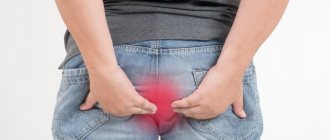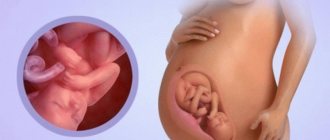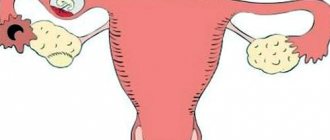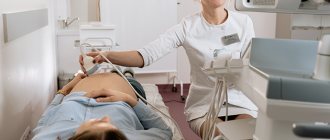Pain in the intestines can indicate various problems in the body. Symptomatic treatment in such cases is prescribed based on the specifics of the sensations themselves (how pronounced they are, where they are localized, how often they appear, etc.) and the presence of other manifestations of the malaise.
As for eliminating the root cause of the disease, if the patient consulted a doctor on time, no problems should arise with this. When should you start sounding the alarm for pain in the rectum? Firstly, medical observation is required in any case in which the patient experiences characteristic discomfort for a day or even more.
Secondly, situations where, in addition to pain, the disease manifests itself with fever or bleeding always imply the need for immediate hospitalization. And finally, thirdly, very special cases are considered to be those when a pregnant woman experiences discomfort.
Haemorrhoids
Hemorrhoids can cause pain in the rectum.
Hemorrhoids are swellings around (and sometimes inside) the anus. The vessels inside such formations are usually greatly dilated.
As a result, the blood forms clots, causing the patient severe discomfort when walking, sitting for long periods of time and, especially, when defecating.
Sometimes the formation of hemorrhoids is accompanied by damage to the skin in the anal area. In such cases, the patient may also have to deal with regular bleeding.
Why do hemorrhoids form? The causes of this disease can be very different. Excessive physical activity, childbirth, or even ordinary constipation can trigger the formation of nodes.
Hemorrhoids during pregnancy - symptoms and treatment
Treatment of hemorrhoids can be divided into three stages:
- lifestyle changes;
- conservative treatment;
- surgery.
Lifestyle change
The first step in treating hemorrhoids of any stage is changes in lifestyle, especially those aspects that affect the development and progression of hemorrhoids. All patients are recommended:
- consume at least 30–40 g of fiber per day (found in beans, peas, white rice, wheat, oats, nuts, almonds, olives and fresh vegetables);
- maintain water balance, i.e. drink at least 1.5 liters per day in the absence of contraindications such as congestive heart failure, as well as certain kidney diseases;
- exclude spicy foods;
- give up alcohol.
The diet is designed to normalize intestinal contractility and form feces of moderate density.
When defecating, you should not strain excessively, and the process should not last more than five minutes, even if during this time it was not possible to wait for a stool. Such recommendations are due to the fact that with prolonged sitting and straining, blood stagnates in the area of hemorrhoids and its outflow becomes difficult. After unsuccessful attempts to “go to the toilet,” it is recommended to give a microenema to facilitate bowel movements, rather than trying with all your might to “squeeze out” the contents.
Compliance with these simple rules for lifestyle changes leads to a decrease or complete disappearance of symptoms in 70% of patients [12]. If the diet does not cope with constipation or diarrhea, then you can use systemic laxatives, for example, with a high content of dietary fiber, petroleum jelly, Lactulose, drugs based on polyethylene glycol, etc. They specifically combat the problem itself, so they can be recommended for pregnant women. The duration of administration is individual, depending on the degree of constipation. The prescription of any medications should be agreed with the attending physician or at least with an obstetrician-gynecologist.
Castor oil and laxatives containing magnesium should not be used due to possible adverse reactions, such as premature stimulation of the pregnant uterus.
Moderate physical activity is also recommended: for pregnant patients, this could be daily walking at a normal pace, light exercise without additional stress, and physical therapy.
Lifestyle changes are most effective in the early stages of hemorrhoid development (I and II). At stages III and IV, such recommendations reduce the severity of symptoms and improve the results of conservative and surgical treatment.
Conservative treatment
Conservative drug therapy involves the use of medications to reduce the severity of hemorrhoid symptoms, however, in the domestic instructions for analgesics, pregnancy is a contraindication. The analgesic effect can be achieved using local anesthetics, which are not absorbed into the general bloodstream and act locally at the site of application. Such drugs include gels, ointments and suppositories with lidocaine or benzocaine.
Preparations based on diosmin (Phlebodia, Phlebofa, Venolek, etc.) are also safe. According to research, taking Diosmin during the development of acute thrombosis in pregnant women reduces the severity of symptoms such as swelling, inflammation and bleeding [13]. It must be remembered that there is no data on the safety of taking diosmin-based drugs during breastfeeding, so the use of these drugs by nursing women is not recommended.
Various hormonal ointments and rectal suppositories are also used, which reduce inflammation, swelling and itching. They work like diosmin-based drugs, but act locally without affecting the developing fetus.
You can take any medications during pregnancy and lactation strictly under the supervision of your doctor, since even the safest medications for the average person can be dangerous to the fetus [7].
Surgery
Radical surgical treatment aimed at removing enlarged hemorrhoids (open hemorrhoidectomy according to Milligan-Morgan or closed hemorrhoidectomy according to Fergusson) is used quite rarely, since the possible risks associated with the intervention and anesthesia often exceed the advisability of the operation, especially since in most cases, hemorrhoids regress after childbirth [12]. The use of sedatives and painkillers during surgery can adversely affect the blood circulation of the mother and fetus.
After eliminating the leading factor in the development of hemorrhoids - pregnancy - enlarged hemorrhoids gradually return to normal. Only if severe symptoms persist and there is no effect from conservative therapy, it is possible to perform individual operations with the least intervention in the body.
For example, in case of thrombosis of external hemorrhoids with severe pain in pregnant women, it is advisable to perform thrombectomy under local anesthesia. The essence of the operation is to remove the blood clot while preserving the hemorrhoidal plexus or to remove a specific thrombosed hemorrhoidal node. This procedure rarely takes more than ten minutes and is practically painless, but effectively and quickly relieves pain.
Ligation of hemorrhoids with latex rings can also be considered as a method of surgical treatment, which is used for repeated bleeding from the internal hemorrhoidal plexuses. Its essence lies in applying a latex (rubber) ring to the leg of the node where the artery directly passes. The ring compresses the artery, and without adequate blood supply, the node atrophies, its walls stick together and it gradually shrinks. The operation is performed on an outpatient basis under local anesthesia, but is only indicated for symptoms of internal hemorrhoids. With enlarged external nodes or combined hemorrhoids, this technique is ineffective [8][9].
Anal fissures
Anal fissures are damage to the anal canal.
The end of the lower part of the rectum, which is a short tube surrounded by muscles, is called the anal canal.
Any physical damage to the integument of this organ usually causes characteristic pain in the patient. It is this condition that doctors call anal fissure.
The described disease in its symptomatic manifestations almost completely coincides with hemorrhoids. Yes, and both mentioned ailments are treated in the same way. The whole essence of therapy in both cases comes down to making the process of defecation easier for the patient by softening the stool.
What hurts in the back or leg during pregnancy?
The cause of pain in the lower back, buttock or leg is not always the sciatic nerve. In most cases, problems are caused by ligaments, muscles and joints. It is their work that you should pay attention to when diagnosing and treating such back pain.
Even in the case of true neuritis, the culprit of the pathology is often a muscle. In the gluteal region, the sciatic nerve passes under the small but tight piriformis muscle. When it spasms, the nerve is compressed and inflamed.
If the buttocks or lower back ache or “shoot”, the stabilizer muscles of the back make themselves felt. Normally, part of their work is performed by the powerful abdominal muscles. During pregnancy, their function is “turned off”. Relatively small back muscles have to withstand ever-increasing loads.
The same can be said about pain in the back of the thigh. The muscles of this zone have to constantly “pull” the displaced center of gravity of the expectant mother. Despite the fact that the described pathologies are not particularly dangerous, if there is any pain, a pregnant woman should contact her doctor.
Methods of treatment and pain relief
If the doctor excludes potentially dangerous conditions, the pregnant woman is recommended to correct unfavorable factors. Considering that medications are contraindicated during this period, emphasis is placed on physical methods. The following measures have the greatest effect:
- Correct physical exercises under the supervision of a rehabilitation specialist. The basis of the fight against pain in the musculoskeletal system is active work with the muscles. Therapeutic exercise stabilizes and strengthens weak muscles, allowing you to feel active longer throughout the day.
- Gentle massage and stretching. In addition to strengthening weak muscles, you need to relax spasmodic muscles. Relaxation has a remarkable effect on piriformis syndrome, trigger points of the buttocks and legs. Massagers and kinesio tapes also help the expectant mother.
- A good bandage for pregnant women. The right abdominal support belt relieves back muscles and often completely eliminates pain. It is important to choose a certified and high-quality bandage so that it is not only safe, but also works effectively.
If you experience any pain during pregnancy, consult your doctor. After the doctor’s visit, we recommend visiting one of the many stores “ORTO SMART - Medtechnika, orthosalon.” We have comfortable and effective bandages for pregnant women, massagers, tapes and pleasant anatomical pillows. Professional consultants will help you choose the most suitable products to make your pregnancy more pleasant and comfortable.
Abscess
An anal abscess is an abscess that forms in the anus. Directly connecting the skin around the sphincter to the infected area, such a formation can bring a lot of discomfort to the patient.
In addition to the characteristic pulsating discomfort in the rectal area, which intensifies with changes in body position, abscesses can manifest themselves as follows:
- irritation of the skin in the anal sphincter area, accompanied by swelling and redness;
- discharge of blood and pus during bowel movements and urination;
- fever (fever, fever, general weakness, etc.).
With successful diagnosis of the inflammatory process at an early stage, the abscess can be successfully treated with antibiotics. However, if such treatment is delayed, they prefer to remove the abscesses surgically.
Proctalgia
Crohn's disease causes bloody diarrhea.
This condition is characterized by severe, almost unbearable pain in the lower parts of the rectum, as well as in the anal sphincter area.
Most often, the cause of this reaction is an old injury, as a result of which the pelvic muscles cramp.
Unfortunately, the time of the next attack of proctalgia is almost impossible to predict. Pain syndrome with this disease always occurs suddenly.
How is proctalgia treated? Diagnosis of this disease is carried out by surgeons and psychotherapists. It is these specialists that the patient should visit for consultation first. Treatment (usually consisting of medication) must also be prescribed by a doctor. The patient can only strictly follow his recommendations.
The effect of pregnancy on the musculoskeletal system
The task of hormones in the last trimester of pregnancy is to prepare a woman’s birth canal for the passage of a relatively large fetus. The ligaments soften and relax, and changes occur not only in the pelvis. Connective tissue relaxing hormones affect the spine, vein wall, knee and ankle stabilizers.
It is during pregnancy that flat feet, varicose veins, and lumbar pain syndrome often appear or worsen. In addition to hormonal imbalance, banal overload is also of great importance. The weight of the child and amniotic fluid, the center of gravity shifted forward, and difficulties during physical education create conditions that are quite unfavorable for the joints and back.
How does the sciatic nerve hurt?
Sciatic nerve pain during pregnancy is a characteristic and common problem. More than half of pregnant women report some form of back strain. But is the sciatic nerve to blame?
This nerve trunk is the largest nerve in the body. It stretches from the lower back to the fingertips. True sciatic neuritis is manifested by the following symptoms:
- Sharp or aching, burning or boring pain along the buttock or leg.
- Numbness of the foot, back of the thigh, buttocks.
- Weakness or paralysis of the foot or hip.
Not all women with back or leg pain experience a similar picture. Most often, completely different elements hurt in the back. If typical elements of neuritis are still present, you should definitely not hesitate to seek help.
Crohn's disease
Many inflammatory bowel diseases manifest themselves in the form of specific pain. Crohn's disease is just one of them, the most common. Other characteristic symptoms of this disease are:
- convulsions;
- bloody diarrhea;
- sudden weight loss.
Diagnosis (and, consequently, prescribing treatment) for this disease should be carried out exclusively by specialists. As a rule, doctors prescribe purely symptomatic therapy to patients with Crohn's disease. This usually involves taking special medications.
Oncology
Rectal cancer manifests itself in the same way as hemorrhoids.
Cancer of the rectum or anus usually presents in the same way as hemorrhoids.
Correct diagnosis of such diseases is usually helped by characteristic symptoms such as anal bleeding and bowel movements. Moreover, over time, all the mentioned signs of the disease begin to manifest themselves more and more.
To confirm or refute suspicion of oncology, the patient should consult a surgeon specializing in such diseases. After a physical examination, the doctor will likely refer the patient for additional tests (stool test, biopsy, etc.).
How to get rid of constipation during pregnancy?
You can regulate your stool using medicinal and non-medicinal methods. Sometimes a few lifestyle changes are all it takes to make bowel movements easier3. If stool retention is caused by iron supplements, your doctor will help you adjust your regimen so as not to worsen your symptoms12. Most pregnant women experience relief from symptoms simply by increasing their fiber and fluid intake.3
Up to contents
Dietary recommendations
Pregnant women suffering from constipation are recommended to eat more frequently and in smaller quantities8. The diet should include foods rich in fiber - its daily volume should be 20-35 grams4.
If you have stool retention, it is recommended to use8,10:
- cereal grains and wholemeal bread;
- fruit and vegetable juices (apricot, plum, peach, pumpkin and carrot);
- figs, dates, prunes, dried apricots;
- sour apples;
- dairy products.
Dietary fiber (fiber) should be consumed with sufficient fluid, adding approximately 2-3 glasses of fluid per day in addition to the main volume10.
If constipation is associated with weakened colon peristalsis, vegetable oils (sunflower and olive) can be included in the diet10.
It is better to limit or completely eliminate from your diet foods that can cause constipation or aggravate it. These products include7:
- strong coffee and tea;
- bread made from premium flour;
- semolina;
- whole milk;
- chocolate.
Up to contents
Drinking regime
Adequate fluid intake is an important component of non-drug therapy for defecation disorders. The recommended daily fluid volume is at least 2 liters, unless there are restrictions caused, for example, by edema in the last trimester of pregnancy2,10.
Up to contents
Folk remedies
Not all folk remedies that are traditionally used to relieve constipation are suitable for pregnant women. When resorting to traditional medicine recipes, you should be careful and consult a specialist, since some plants are contraindicated during pregnancy. For example, products such as buckthorn bark, rhubarb, and joster fruit are best avoided during pregnancy due to their potential toxic effects on the liver and kidneys, as well as the likelihood of developing “inert colon,” a condition in which the intestines lose the ability to push feces through. mass2.
It is also not recommended to use mineral and castor oils, as they slow down the absorption of fat-soluble vitamins in the intestines and stimulate premature uterine contractions5.
Up to contents
Drug treatment
If non-drug methods do not help or have little effect, the doctor may prescribe a drug with a laxative effect to the pregnant woman11. The following laxatives1 can be used:
- Alimentary fiber . They increase the volume of stool and facilitate bowel movements3. At the same time, it is important to remember that this group of drugs can only be prescribed if the pregnant woman is allowed to drink enough fluids. If you are prone to edema, when doctors recommend reducing the amount of water consumed, dietary fiber will not have the desired effect2,7.
- Osmotic laxatives. They act by increasing the amount of fluid retained in the intestinal lumen3. These drugs can cause severe diarrhea, due to which the body loses a lot of fluid and salts, so they are rarely prescribed during pregnancy2.
- Stimulant laxatives. Increases fluid secretion in the colon, which improves peristalsis3. In pregnant women, their use is limited because they can cause reflex contractions of the uterus7. Some stimulant laxatives are completely contraindicated during pregnancy due to risks to the health of the fetus8.
As you can see, due to the risk of side effects, it is difficult to find a laxative that is safe during pregnancy, especially if it must be taken orally. But there are drugs with combined action in the form of microenemas that act at the level of the rectum. One of these medications that a doctor can prescribe for the symptomatic relief of constipation in pregnant women is MICROLAX® 14.
MICROLAX® is a combination drug with a laxative effect. It is realized through peptization of feces - the transition of large particles into small ones, which are easily removed from the intestine14.
Sodium citrate, sodium lauryl sulfoacetate and sorbitol, which are part of MICROLAX®, have a complex effect.14 Under the influence of the drug:14
- Bound water is displaced from the feces, dense feces are destroyed into smaller fragments;
- by stimulating the flow of water into the lumen of the colon, the intestinal contents are liquefied and the laxative effect is enhanced.
MICROLAX® helps to quickly soften dense stool and facilitate bowel movements. According to the instructions, the therapeutic effect occurs within 5–15 minutes after administration of the microenema14. Pregnancy is not a contraindication to the use of the drug - MICROLAX® is safe for pregnant women and can be used from birth14.
Remember that before using any laxatives, the expectant mother should consult a doctor so that he can control the regimen of use of the drug and dose.
Up to contents
Other diseases that cause rectal pain
Prostatitis can also cause pain in the rectum.
Pain in the intestines is not always a sign of problems with this organ.
Diseases affecting other systems of the body (usually the genitourinary system) often manifest themselves in this way:
- rising pain syndrome (characterized by constant or periodic pressure around the anus, more common in women);
- infections caused by a fungus or STD (most often HIV, gonorrhea, syphilis, chlamydia or herpes);
- arthritis and bone tumors (pain in the tailbone can spread to the entire pelvic area, which can mistakenly suggest problems with the intestines);
- prostatitis (as well as other urinary tract problems);
- psoriasis (like some other skin conditions, such as warts, inflammation can affect the area near the anus and cause symptoms characteristic of rectal problems).
This video will tell you what may cause pain in the rectum:
Causes of pain in the anus during pregnancy
In addition to the usual factors that can cause pain and discomfort in the anus during pregnancy, new factors appear that contribute to this:
- Enlargement of the uterus and fetus creates increased pressure on the rectum. This leads to stagnation of blood, which can cause enlarged veins and the formation of hemorrhoids.
- In the later stages of pregnancy, intra-abdominal pressure increases, which also provokes exacerbation or the formation of hemorrhoids.
- During pregnancy, the natural level of immunity decreases, which can cause inflammatory diseases to worsen or appear, including colitis and proctitis, which also cause pain.
- Constipation. During pregnancy, the body produces substances that reduce the activity and motor functions of the intestines. This is necessary to reduce the likelihood of premature birth, but this creates the prerequisites for constipation. It can be triggered by poor diet and low level of physical activity.
The listed factors most often become the cause of pain in the anus in pregnant women. They create the prerequisites for the development of rectal diseases.
If the patient is pregnant
Pregnancy is a special state of the body in which any, even the most insignificant “sore” can lead to very serious consequences for the woman and her unborn child.
Therefore, if a lady is really worried about the health of her unborn baby, she should not ignore such an alarming symptom as pain in the rectum. What is the specificity of this condition during pregnancy?
Unfortunately, while a woman is pregnant, the internal pressure in her abdominal cavity increases greatly. And, as the child develops in utero, this figure only grows. Due to constant pressure on the rectum, a woman may experience characteristic pain.
However, this is far from the worst thing. An enlarged uterus is fraught for the expectant mother with an exacerbation of all her existing chronic intestinal diseases (for example, colitis or proctitis), as well as the appearance of new ones: hemorrhoids and regular constipation caused by impaired peristalsis.
Pain in early pregnancy
03.11.2020
Pregnancy is a wonderful time for a woman, but sometimes it is overshadowed by unpleasant moments, such as worries about your ailments and concerns about the health of the baby. Throughout pregnancy , a woman experiences pain of various types; for the most part, there is no need to be afraid of these sensations; as a rule, such pain is associated with changes in the body and is the norm.
“Correct” obstetric pain
- The first pain sensations during pregnancy are associated with implantation of the egg into the uterine . Such pains are aching or tingling, not intense, and may be accompanied by slight bleeding. They occur in the first week and a half after ovulation and go away on their own. Such pain signals conception even before it is possible to diagnose pregnancy on an ultrasound .
- “Useful” can be called mild pain in the early stages of pregnancy in the lower abdomen in the area of one of the ovaries . Such sensations are associated with the growth of the ovarian corpus luteum cyst, which is responsible for the production of pregnancy hormone progesterone. The more progesterone is produced, the easier pregnancy . Sensations occur only before the placenta matures, approximately the first 3 months.
- , which is necessary for greater elasticity of the uterus, affects the vertebral discs, which, when the center of gravity shifts, causes discomfort to the woman in the form of lower back . They may appear from time to time or accompany throughout pregnancy , intensifying with fatigue from physical activity. Such pain is more common and more intense in women with spinal or osteochondrosis .
Dangerous obstetric pain
- An ectopic pregnancy can cause severe pain in early pregnancy , radiating to the sacrum or rectum , and spotting. During such a pregnancy, the egg does not attach to the lining of the uterus , but remains in the fallopian tube, continuing its growth there, and as a result, ruptures it. The pipe can be saved only if you consult a doctor .
- Troubles may be associated with a lack of progesterone. When the egg cannot attach, nagging pain appears, which leads to miscarriage if you do not start taking artificial progesterone.
- Spontaneous abortion is accompanied by sharp, severe pain, aching and pulling, in the lower abdomen and lower back , and bleeding. If left untreated, the pain becomes cramping. to maintain your pregnancy if you consult a doctor at the beginning of the process.
Common non-obstetric pain
- Soreness, increased sensitivity and swelling are characterized by changes in the mammary glands during pregnancy . Particular pain is felt in the first three months, but the sensations may return at the very end of pregnancy . The growth of glandular tissue occurs as a result of hormonal changes, in order to prepare the breasts for lactation.
- Early signs of pregnancy include frequent headaches caused by changes in hormonal levels and increased venous pressure. This cannot but affect the nervous system and causes migraines - but does not harm the fetus. However, if the pain is caused by changes in blood pressure, then this may signal danger for the woman and fetus.
Dangerous non-obstetric pain
- From the first weeks, immunity begins to decline, which can lead to an exacerbation of any chronic diseases and pain in connection with this. Such exacerbations can harm the mother and cause the development of pathologies and abnormalities in the development of the fetus. Even at the planning stage, it is necessary to undergo examinations and, if necessary, a course of treatment.
- Often, pain in early pregnancy can be caused by attacks of appendicitis . This happens due to weakened immunity and changes in hormonal levels. They are accompanied by attacks of nausea , vomiting and fever.
- Another common condition is cystitis , which can lead to pyelonephritis if left untreated. This can become a serious threat to the continuation of pregnancy and negatively affect the woman’s health. As a rule, pyelonephritis is characterized by severe pain in the lower back , and with cystitis the pain is weak, felt more like discomfort.
Most diseases during pregnancy need to be treated in a hospital , under the constant supervision of a doctor . Of course, you shouldn’t worry about mild painful, non-dangerous sensations, but you need to remember that you are already responsible not only for yourself, but also for the nascent life of the little person, and negligence can cost both of you very dearly.
Published in Pregnancy and pregnancy management Premium Clinic








